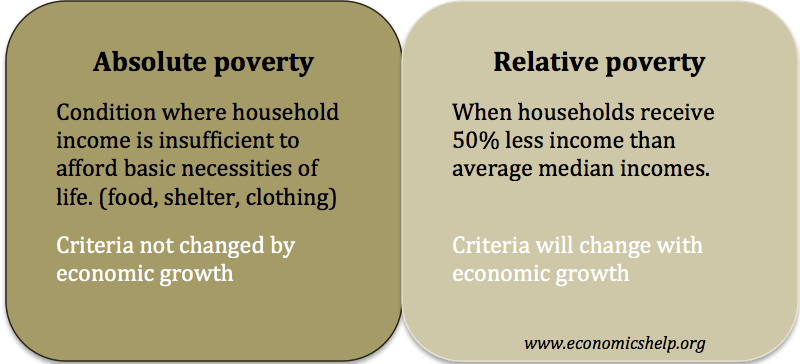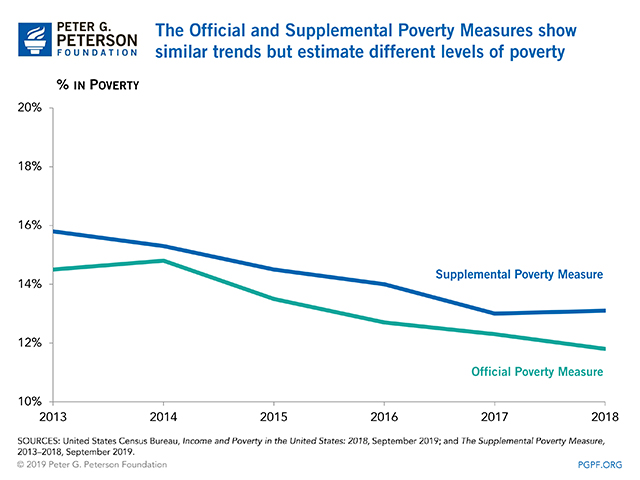Explain About the Different Measures of Poverty
Absolute poverty is defined as the lack of sufficient resources with which to keep body and soul together. Juan says that average inflation over the last 50.

Definition Of Absolute And Relative Poverty Economics Help
Department of Agricultures economy food plan multiplied by a factor of three.

. Poverty results from problems in society that lead to a lack of opportunity and a lack of jobs. See the answer See the answer done loading. It is not surprisingly the most commonly calculated poverty measure.
The government then estimates the national poverty rate using this line sometimes with technical assistance from the World Bank and publishes it as its official poverty estimate. Absolute poverty refers to the minimum physical needs that are associated with physical survival taking account of food clothing and shelter Roll 1992 14. Poverty lines tend to be defined using three methods.
Explain how different measures of inflation could. Although most of the literature focuses on indicators of deprivation such as income food access to housing and so on the choice of indicators to measure levels of deprivation can often be arbitrary and hence may not reflect a full-scale. It identifies the share of a population whose income is less than the poverty line.
Poverty is a multidimensional concept that seeks to measure levels of deprivation encountered by a person household or community. The multiplier was based on research showing that food costs then accounted for about one-third of money income. The measure literally counts heads allowing policymakers and researchers to track the most immediate dimension of the.
This approach focuses on quality of life as the determining factor for a poverty headcount. The WDI compiles the poverty headcount ratio measured at the national poverty line a threshold which is individually determined by each countrys government. Result in different poverty rate trends over time.
Conventional measures of poverty relate household per capita income or expenditure estimates to a poverty line derived from a nutrition-based estimate of minimum income or. Poverty can be measured by. Control of population - to remove poverty controlling of population is important.
It increases per capita income. Relative poverty on the other hand refers to inequality in distribution of income and expenditure. The United States in contrast uses an absolute poverty measure.
Situational generational absolute relative urban and rural. It is a widely used measure to ascertain poverty rates in. India started family planning in 1951 however it must be made more aware to the people.
P Absolute poverty. Poverty can be measured in different ways - different measures tell us different things. I Inequality index.
There are two types of poverty depending on the way that it is measured those types are. The headcount is the simplest and best known poverty measure. Income only net household income poverty before housing costs Disposable income - net household income after housing costs poverty after housing costs.
Relative and absolute poverty. Iv Poverty also means lack of clean water and sanitation facilities. Level of per capita income has a positive effect on welfare whereas inequality I and absolute poverty P negatively affect welfare.
Inflation can be measured in various ways. Poverty is a state or condition in which a person or community lacks the financial resources and essentials for a minimum standard of living. Food energy intake expenditure or income per capita against food consumption in calories per.
Rather the variety of focuses should lead us to conclude first that poverty is not about the lack of one thing but of many. Juana says that average inflation was 3. These four approaches to poverty have different focuses and note many important aspects of what poverty is.
Poverty-stricken people and families might go without. Such requirements may include shelter clothing food education and healthcare. According to UNESCO evaluating poverty this way takes into account income as well as two additional perspectives.
Situational poverty is generally caused by a sudden crisis or loss and is often temporary. The US poverty line was created in 196364 and was based on the dollar costs of the US. There are basically three current definitions of poverty in common usage.
The cost of basic needs estimated cost of acquiring enough food for adequate nutrition plus the cost of other essentials such as clothing and shelter which is generally the preferred approach. In this type of poverty people who are living below the aforementioned poverty threshold are not affected even if the country they live in is economically thriving. Poverty can either be relative or absolute because whereas other people may be comfortable with their lives they may be deemed to be.
Ii It is a situation in which parents are not able to send their children to schools. Verified by Toppr There are several dimensions of poverty. Which measure of inflation will result.
Poverty results from the fact that poor people lack the motivation to work and have certain beliefs and values that contribute to their poverty. But we would be reducing it if we were to equate one of those aspects to poverty itself. Relative poverty defines income or resources in relation to the average.
Increase in employment opportunities - employment opportunities must be made for people in rural areas. That is given the per capita income the higher income inequality. Absolute poverty refers to inability of a section of population to achieve basic necessities of life.
In other words poverty. I Poverty means hunger and lack of shelters. Usually relative poverty is measured as the percentage of the population with income less than some fixed proportion of median income.
There are six types of poverty. The absolute measurements counterpart is that of relative poverty. Absolute poverty relative poverty and social exclusion.
There are two types of poverty absolute poverty and relative poverty. Iii It is a situation where sick people cannot afford treatment. Poverty can be measured in terms of the number of people living below this line with the incidence of poverty expressed as the head count ratio HCR or the poverty ratio - number of poor to the total population expressed as percentage.
Poverty can be defined as the lack of basic needs that are necessary for one to lead a relatively comfortable life. Basic needs and empowerment. This concept measures poverty only in relation to the amount of money necessary to meet basic needs such as food clothing shelter safe drinking water education healthcare etc.


No comments for "Explain About the Different Measures of Poverty"
Post a Comment